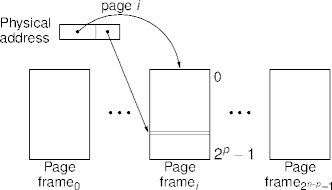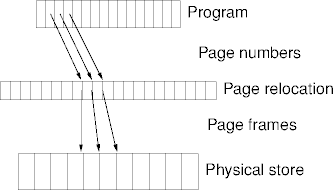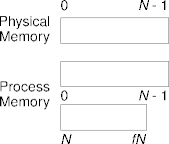Operating Systems Lecture Notes
7 March 2012 • Virtual Store
Outline
- Big programs and overlays.
- Virtual Store and addressing.
- Address translation.
- Page management.
Big Programs, Small Storage
- We still need to run programs bigger than primary store.
- Overlays use programmer-defined fragments.
- Virtual store and paging use system-defined fragments.
- Both the hardware and os are invoved.
- But not programmers, unless they want to.
Big Programs
- Big programs excede physical store.

- They use addresses from N up.
- Cut big program into pieces.
Big Addresses
|
|
|
- Rather than adding a base, subtract it.
- Or just compile the second half with base 0.
Relocation
- A program is twice as long as physical store.
- Cut the program in half.
- Relocate the top-half addresses by -N.
- Now both halves of the program have addresses in the range 0 to N - 1.
- This works only when each half is independent of the other.
- Addresses are recycled, and so are ambiguous.
Management
- Transitions between halves is done by system call.
- The OS
- Writes the old half to disk to save modified data.
- Optional if no data was written
- Reads in the new half, resets the process state, and returns.
- Writes the old half to disk to save modified data.
- This is expensive.
Overlays
- Overlays generalize the two-part program.
- An overlay is a program fragment relocated to a
physical-storage segment known as an overlay region.
- Several overlays may map into the same physical-storage segment.
- A program may comprise several overlay regions.
Overlay Definitions
- The programmer defines the overlays and overlay regions.
- Usually via program structure and linker incantations.
- The compiler creates them.
- The OS implements them.
- There’s no protection against mis-alignment or mis-referencing.
Virtual Store
- Make overlays small and regular.
- Programs are automatically fragmented into pages.
- Some address translation trickery provides virtual storage.
- Virtual addresses - completely decouple physical and process addresses.
- Virtual memory fragments - pages.
- Virtual addresses - page number, page offset.
Paging
- Pages are uniform overlays.
- Memory management unit (MMU) - virtual to real address mapping.
- Translation look-aside buffer (TLB) - speeding up the MMU.
- Inverted page tables.
Pages
- The process address space is divided into pages.
- Physical memory is divided into page frames.
- Page frames and pages are (usually) the same size.
- Usually around 1 to 4 kbytes (210 to 212 bytes).
- A small multiple of the disk-block size.
Virtual Store
- Virtual store is like physical store, except that virtual store
doesn’t exist.
- A conceptual fixed-length array of units.
- VS units are the same size as PS units.
- N, the virtual-store size, is usually vastly larger than
physical-store size.
- It can also be smaller, or the same size.
- N is usually 232 (4.2 gig) or 264.
Example

Virtual Addresses
- A virtual address is an index in the conceptual array.
- Pages give virtual addresses a structure not found in physical addresses.
- A virtual address identifies both
- the page containing the unit, and
- the offset of the unit within the page.
VA Structure
- Let page size be 2p units (10 ≤ p ≤ 12 say).
- Let a virtual address be n bits (n = 32 or 64, say).
- The page offset is the leftmost p bits of a virtual address.
- The page number (or index) is the rightmost (n - p) bits of the virtual address.

Management
- Virtual addresses have to be mapped to physical addresses.
- Page tables map from virtual address to page frames.
- Issues
- Page table size - the trade-off.
- Translation speed - as fast as possible.
- Context switch overhead - as low as possible.
Page Tables
- Single level page tables.
- Registers - small and expensive but fast.
- Main store - big and cheap but slow.
- Multi-level page tables - 219 8k pages in 32-bit address space.
- Page table entries - page frame number, present-absent bit, protection bits, modified-referenced bits, cache bit, pinned bit.
Example

Translation Look-Aside Buffer
- The MMU has to be fast and small to keep costs down.
- Speeding up the MMU.
- Caching page table to page frame mappings
- Hardware or software.
- Prefetching - process stack + code.
TLB Example
- For example, consider 50 ms TLB lookup, 750 ms store access.
- TLB hit: 50 tlb + 750 store access
- TLB miss: 50 tlb + 750 page table access + 750 store access
- A 8-16 entry TLB has a 80-90% hit ratio.
Inverted Page Tables
- 64-bit addresses with 16k page frames, 248 = 281*1012 pages.
- Page frame → (proc, page no) mappings
- 232 mbyte main store → 216 216 kbyte page frames.
- Use a TLB to speed-up mapping.
- Use hashing on addresses when the TLB misses.
Page Replacement
- What to do when good addresses go bad?
- Page faults.
- Random page selection - yank any in-store page; not very efficient.
- Optimal page replacement - furthest use in the future.
Used-Based Replacement
- Toss pages not recently used.
- Modified & referenced bits.
- Periodically clear reference bits to find old, unreferenced pages
- Toss not referenced before referenced pages, and not modified before modified pages.
- Hardware implementation - still need to clear reference bits.
- Software - interrupts and protection.
Related Strategies
- Fifo - oldest out next; no reference or modify checking.
- Second chance - oldest unreferenced out.
- Clock page replacement - second chance or fifo as a ring.
LRU Replacement
- The past as prolog.
- Page queue ordered by access time.
- Counters-based timers.
- Matrix-based timers
LRU Analysis
- LRU simulations.
- Not frequently used adds a read bit to a counter; doesn’t forget.
- Aging shifts the read bit in from the right.
- LRU problems.
- There is no intra-interval granularity.
- Resolution is finite and small.
Design Issues
- working set model
- local vs. global page allocations
- page size
- the store-management interface
Working Set Model
- Demand paging.
- Locality of reference.
- Working set.
- Thrashing
- Prefetch
- Using counters to compute the working set.
- Adding the working set to paging algorithms - wsclock.
Local vs. Global Page Allocations
- Fractional vs. weighted total allocations.
- Managing by page-fault frequency.
- Swapping is still useful to handle global thrashing.
Page size
- Set by hardware or software - alpha 8, 16, 32, 64kb pages.
- Internal fragment, small segments argues for small pages.
- Small page tables, paging overhead argues for large pages.
- Page table overhead on context switches.
Summary
- Overlays fold large programs into small physical store.
- Pages are small, regular, system maintained overlays.
- Page address structure leads to virtual store.
- Hardware assist makes for dynamic relocation.
- Page management trades-off allocation for residency.
| This page last modified on 2012 March 7. |

